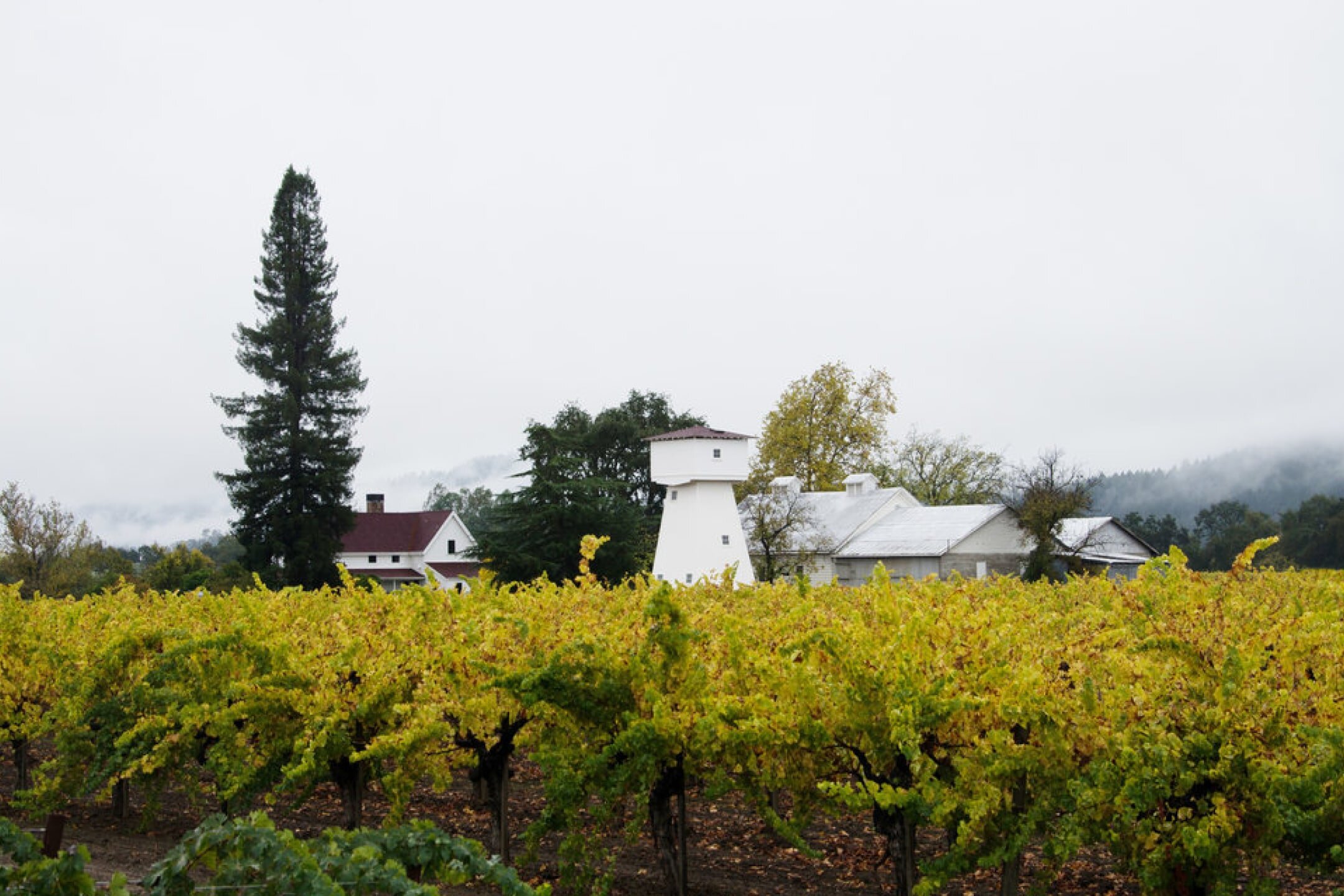The Story of Innovation at Frog’s Leap Winery
Or how a jaded somm found wonder at her most unlikely source.
Adamson Barn at Frog’s Leap Winery in 1884.
Years ago when I took over the wine program at a luxury hotel in Chicago, I removed Frog’s Leap from the list early on. In my mind, it was lumped together with the deluge of mid-priced non-remarkable Napa wine that had flooded the market in the past 10 years. I was disillusioned with Napa, tired of the guests coming in and asking me what I had that was like Caymus, tired of guests focused on how many points a wine had received from Robert Parker and the way the Napa wine community seemed to have adjusted its entire style of winemaking to adapt to the tastes of this one all-powerful man.
Fortunately, I had a distributor rep who brought me several iterations of Frog’s Leap to taste. I realized these wines deserved another look; they were different; they exhibited an air of subtlety, perhaps the precise opposite of what was imbued upon so many wines crafted in the 100 point mold. I realized I had been wrong. I like to think discovering you were wrong is one of the markers for a good sommelier. The wonder is what keeps us engaged in the profession-- the open mind, the ability to change opinions when presented with new information. Therefore, I can proudly state that I was wrong about Frog’s Leap, and to an extent, wrong about Napa.
This was the beginning of my journey to truly appreciate Napa, its past and its present. A couple years later, I would find myself on a one-day journey through several Napa wineries that would make me look so much deeper into the place, I would one day consider calling it home. I had been invited to participate in a fund-raising gala for the One Mind Foundation, started by Staglin Winery to raise funds for mental health research. My guide for the day was Amber Minha, a transplant from Wisconsin whose passion for Napa was unmatched by anyone I had encountered. That was the day I truly got the insider’s peek inside of what was really happening in Napa.
Interior view of Barrel Chai at Frog’s Leap Winery.
One of the most impactful visits of the day was our time at Frog’s Leap. We arrived for a quick and informal tour of the winery and then headed outside for lunch. A long picnic table was set up under a canopy of fruit trees. John Williams, the founder and long-time winemaker of Frog’s Leap was seated at one end, with his wife Tori at the other. The table quickly became filled with a stunning colorful array of dishes. Tori had made her famous molé, and they had traveled cross the valley to get the best fresh-made corn tortillas. Fresh organic fruit and vegetables from the farm abounded, including the most gloriously simple tomato salad I have tasted to this day—-- the ripest, sweetest, loveliest tomatoes—-- I could have eaten all day and never tired of them. We started by tasting the usual suspects, recent releases. Then, one of the somms at the table happened upon the Pandora’s Box of questions—-- “What are your thoughts about how Zinfandel ages, John?.” A glimmer from the winemaker’s eye was a clear indication that something had just been ignited. The next hour was comprised of a flurry of bottle after bottle of Zinfandel being passed around the table, some dating back to the 90s.
John Williams, Founder and Winemaker at Frog’s Leap
John went on to explain that he believes a wine’s ability to age is in direct correlation with how healthy the vineyard was. One of the tenets of his belief system is abstaining from irrigation. He maintains that the vines must be forced to search for water, thereby stretching their roots deeper into the ground in search of nutrients and gaining while simultaneously gaining more complexity from the terroir. Perhaps even more interestingly, John believes that we have to allow a farm or vineyard to find harmony on its own. If we are constantly intervening with chemicals and irrigation, he maintains the vineyard will never be healthy on its own. At this point John cites his neighbors, who do irrigate, and the marked difference even visually in the soil. A shovel struggles to reach through the dry decayed earth mere yards away, while his soil remains lush and vibrant.
A little over a year later on a quest to find out how the seeds of John William’s innovative ideas had been planted, I would find myself sitting across from Jonah Beer, the Vice President of Frog’s Leap for over 20 years. Jonah regularly travels around the country representing Frog’s Leap, but he is far from your ordinary sales rep; his breadth of knowledge in the world of wine is extraordinary. He’s certainly kindly schooled me in a thing or two. Jonah’s traveling a bit less these days, so I was lucky enough to pin him down for a chat. . . and some wine, of course.
Jonah, the ultimate host, suggests his home as our meeting spot. I arrive to find a den somehow striking the balance between almost too beautiful that you don’t want to touch anything and so cozy you have no choice but to sink into the couch. I’ve brought a bottle of Bordeaux. Jonah already has a bottle of White Burgundy, imported by his wife, chilled and ready to go with a snack pairing of salty, crunchy potato chips. Damn. His wine totally beats my wine. And chips. Double damn. This guy is good. I should have expected nothing less.
Jonah Beer, Vice President at Frog’s Leap Winery
In between sips and crunches, Jonah and I get to talking. Jonah moved to Napa in the 1990s after dropping out of law school. He trekked out to Napa and took a job for $2.72 per hour washing glasses at Stag’s Leap, in hopes of foraying into a hands-on role with a winery. Initially, Jonah’s ambition was to become a winemaker, but one conversation with Jonah, and you understand why he ended up in a different role. Gregarious, generous, and professorial in his ability to explain complex concepts, Jonah was one of the first people in Napa to roll out the welcome wagon for me when I arrived this past September for harvest. We met for snacks and wine at Angèle, a delicious Napa haunt. Jonah knew the owner, the servers, and even a couple patrons. It seemed he and his wife Sara knew every other person to walk through the entry. A solitary life in a cave would never have suited this man.
This gregarious nature makes it clear why Jonah was drawn to Frog’s Leap. John Williams had created a sort of community think tank within his winery. John was curious, inclusive, and searching for how to create the best, most expressive product. Jonah goes on to tell me about the origins of John’s somewhat magical vineyard and winery.
While John was initially practicing conventional farming, as taught during his time at UC Davis, he began to wonder if there could be a better way. His recently purchased vineyard seemed to be repeatedly suffering from disease. It was then that Williams decided to seek out assistance from Amigo Bob Cantisano*. Amigo Bob was a bit of an outsider in Napa at the time. He wore dreadlocks, a wiley moustache and beard, and was suspected to indulge in more than an occasional bit of cannabis. This outward appearance had caused a number of luxury wineries to turn up their noses. However, John was eager to learn about the “out there” philosophies of Amigo Bob. John also began meeting with fellow winemakers with similar goals, such as Doug Shafer. They would share different ideas, results of experiments. This embracing of community and sharing of information was the true heart of Napa in the 70s and 80s, and where great work is being done, it still beats today. John Williams was willing to search anywhere, be open to anything-- perhaps the key to leading an invigorating team environment that persists today and seems to repeatedly lead to success at Frog’s Leap.
“This embracing of community and sharing of information was the true heart of Napa in the 70s and 80s, and where great work is being done, it still beats today.”
It was this very atmosphere that drew Jonah to the winery. By the early 2000s, Jonah had fulfilled his desire to work in the wine industry, but it didn’t look like what he had hoped. He worked for an owner/ winemaker who was dogmatic in his philosophy and maintained a stringent work environment with a clear hierarchy that was not to be challenged. The Napa community is notoriously small, and even cheekily described by some members as incestuous. When Jonah got wind of how John Williams was running Frog’s Leap, he made a move that seemed logical to him. He hand-wrote an 8-page letter outlining why he was intrigued by the winery and why he wanted to work there. . . and it worked. One day, Jonah came home to find a message on his answering machine. It was John Williams, and it was no more than a few sentences casually offering Jonah a job, for which the title seemed to be made up on the fly. Jonah had already started at the winery before his salary was even solidified. He said he wasn’t worried because he knew it would be fair if John was running the show.
Trouchard Pond at Frog’s Leap
Jonah goes on to describe how the Frog’s Leap philosophy continues to evolve. Organics and dry farming were embraced early on, primarily as a result of the influence from Amigo Bob. Farming practices continue to push further, embracing similar philosophies to those of Oregon winemaker Mimi Casteel, such as the need to promote mycorrhizae (the symbiotic relationship amongst plants and funghi that promotes health and communication between organisms).
It isn’t only farming practices that have set Frog’s Leap apart. In a world of double thick glass bottles and labels with family crests and Greek gods, Jonah and John had the word “ribbit” imprinted on the winery’s corks. Their logo is one of whimsy, harkening to nature, not the end times. With a glimmer in his eye and grin on his face, Jonah seamlessly weaves discussion of Cartesian philosophy into our conversation. Perhaps, it’s this combination of childlike wonder and remarkable intellect that have been the engine of Frog’s Leap. It’s suddenly clear why Jonah and John get along so well. The drive for higher scores and better reviews that has motivated so many wineries in the area (and disheartened cranky somms like me) does not seem to register as any part of the Frog’s Leap equation.
“Perhaps, it’s this combination of childlike wonder and remarkable intellect that have been the engine of Frog’s Leap.”
Throughout the “Parkerization” of Napa, when loads of wineries shifted their winemaking techniques to bigger, sweeter styles to appease the palate of Robert Parker and his followers, Frog’s Leap held steadily toward their North star. They sought to make the best wine they could, which often meant lower alcohol, higher acid, and more restrained than their point-garnering neighbors. They weren’t interested in throwing extra additives in the wine for the sole goal of seeking out 100 points. Jonah reminds me they weren’t the only ones. Wineries like Mayacamas, Diamond Creek, and Dunn have traditionally eschewed the influence of Robert Parker and other similar critics.
2018 Frog’s Leap Zinfandel
As we wrap up our meeting, Jonah apologizes that he must head out. He has to make a truffle and Burgundy dinner at a friend’s house. I step out into a cool fall evening in wine country, and I make the drive through Napa with my eyes and ears just a bit fresher than they were before.
I set out to learn about Frog’s Leap’s past, but as it turns out, their present is just as interesting. The key to this winery is the curiosity of people like Jonah and John. Nothing is set in stone. New ideas are always welcome, and the possibility of being better drives each day. Innovation is around every corner. I realize that I see this often in Napa. I’ve tasted Ribolla Gialla grown in Napa at a picnic table set up as a make-shift tasting room. I’ve tasted the first white wine efforts of a major Cabernet house. The wines won’t make money. They're really more of a passion project to discover how the most exceptional Chardonnay and Sauvignon Blanc express themselves in Napa Valley. I’ve visited a vineyard that doubles as an herb garden from which the viticulturist makes antioxidant-filled teas. Sure, Highway 29 running down the main strip boasts its fair share of tourist-trap wineries making over-extracted, high alcohol boring Cabernets, but innovation is all around this valley. You just have to look at its heart.
*This article is dedicated to the memory of “Amigo” Bob Cantisano (1951-2020).













